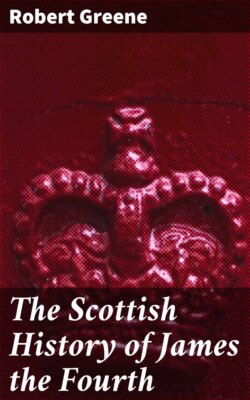Читать книгу The Scottish History of James the Fourth - Robert Greene - Страница 5
На сайте Литреса книга снята с продажи.
List of Characters
ОглавлениеTable of Contents
in order of appearance.
In the Induction and Chorus:
Oberon, king of fairies.
Bohan, a Scot.
Slipper } his sons.
Nano }
an antic (dance), fairies, a dancer ‘boy or wench’.
In the Dumb Shows:
Semiramis, queen of Assiria.
Stabrobates, king of India.
Cyrus, king of Persia.
Olive Pat, (?).
Alexander, king of Macedon.
Sesostris, king of Egypt.
In the Play:
The King of Scots.
The King of England.
Dorothea, his daughter, wife of the King of Scots.
The Countess of Arran.
Ida, her daughter.
Ateukin (or Gnato).
Andrew Snoord, a servingman.
Slipper, a clown.
Nano, a dwarf.
Sir Bartram, a Scottish gentleman.
Sir Eustace (Dick), an English gentleman.
(A Servant of Sir Bartram.)
The Bishop of Saint Andrews.
Earl Douglas.
Lord Morton.
a Purveyor.
Jaques, a Frenchman.
Lord Ross.
a Huntsman.
a Tailor.
a Shoemaker.
a Cutler.
Sir Cutbert Anderson.
Lady Anderson.
a Servant of the Countess of Arran.
a Lawyer.
a Merchant.
a Divine.
a Scout.
Lady Douglas, Sir Egmond, Lord Percy, Samles, an English Herald, lords, ladies, huntsmen, soldiers, antics.
In V. iii the speeches of the King of England have the prefix ‘Arius’ (ll. 2095, 2105, 2126, 2129), a name which in a stage-direction in II. ii (l. 1050) is apparently applied to the King of Scots. Ateukin (twice misprinted ‘Auteukin’, ll. 1451, 2562) is repeatedly called Gnato, which would seem to have been the original name of the character, subsequently altered, for in I. i ‘Ateukin’ several times scans as a dissyllable (ll. 355, 362, 365). Twice Ateukin and Gnato are mentioned together in a stage-direction (ll. 1550, 2053), apparently through misunderstanding of an alteration. Sir Eustace, who is also addressed as Lord Eustace, is several times called Dick (ll. 565, 568, 571, 601, 608, 629). One speech (l. 629) assigned to him, clearly belongs to a servant, who has therefore been added to the characters. In II. ii Nano is throughout called ‘Dwarfe’ except in the exit at l. 1049. Andrew’s surname appears from l. 551. The name of the King of Fairies is Oberon: ‘Oboram’ on the title and ‘Obiran’ in l. 1934. seem to be mere misprints, and ‘Obiron’ (ll. 1164, 1923, 1931) a sporadic variant. In l. 2 his name is given as ‘After Oberõ’, but this is most likely a misprint for ‘after Oberõ’. Dyce supposed that Oberon entered at l. 2398, and Grosart assumed that ‘Adam’ was the name of the actor who played the part, but it is more likely to be a compositor’s misreading of ‘A danc(e)’. At l. 1953 the direction ‘Ladie Anderson ouerheares’ is due to a misunderstanding; it should be ‘Sir Cutbert’. Lady Douglas and Sir Egmond are mentioned in l. 1606 as present, but nothing further is known of them: Lord Percy and Samles enter in V. iii (l. 2094), and the former again in V. vi (l. 2407), also the English herald in V. vi (l. 2338), but none of them speak. Nano does not speak in the Induction.
In l. 656 (cf. 666) the form ‘Staurobates’, in place of Stabrobates, proves that Greene drew from Poggio’s Latin translation of Diodorus Siculus and not from the original.
The text of the play contains nothing to identify either the English or the Scottish king, and the date 1520 given in the Induction is seven years after the death of James IV at Flodden.
The two collotype plates represent A2 recto (title page) and A3 recto in the Dyce copy of the original.
THE
SCOTTISH
Historie of Iames the
fourth, slaine at Flodden.
Entermixed with a pleasant Comedie, presented by
Oboram King of Fayeries:
As it hath bene sundrie times publikely
plaide.
Written by Robert Greene, Maister of Arts.
Omne tulit punctum.
LONDON
Printed by Thomas Creede. 1598.
THE SCOTTISH
Hystorie of Iames the
fourth, slaine at Flodden.
